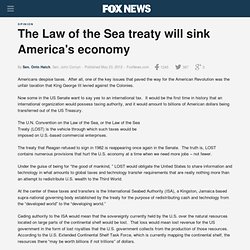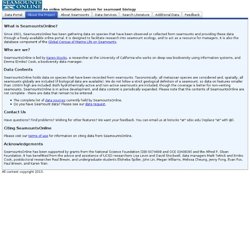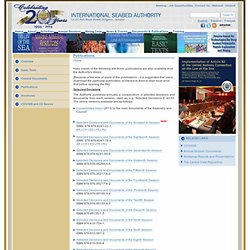

Underwater Mining Institute Conference. The Law of the Sea treaty will sink America's economy. Americans despise taxes.

After all, one of the key issues that paved the way for the American Revolution was the unfair taxation that King George III levied against the Colonies. Now some in the US Senate want to say yes to an international tax. It would be the first time in history that an international organization would possess taxing authority, and it would amount to billions of American dollars being transferred out of the US Treasury. The U.N. Convention on the Law of the Sea, or the Law of the Sea Treaty (LOST) is the vehicle through which such taxes would be imposed on U.S. The treaty that Reagan refused to sign in 1982 is reappearing once again in the Senate. Under the guise of being for “the good of mankind, ” LOST would obligate the United States to share information and technology in what amounts to global taxes and technology transfer requirements that are really nothing more than an attempt to redistribute U.S. wealth to the Third World.
The Deep-Sea Resources Sigils Brief. Human societies currently face dwindling resources and rising competition for them in the contemporary “resources order.”

Thus, besides and in accordance with other ways to handle this challenge, new types and sources of resources are increasingly valuable and can make a strategic difference for polities, as well as for humanity as a whole. Meanwhile, if we are to ever learn from our worrying present, we must also, continuously, make sure that the extraction and use of those new potential resources will not have any unfavourable impact on the planet and its ecosystem, including this biodiversity to which we belong.* World Bank – Global Economic Prospects January 2012 – Commodity Annex. Sensitization Seminar - New York 2012. SENSITISATION SEMINAR ON THE WORK OF THE INTERNATIONALSEABED AUTHORITY AND CURRENT ISSUES RELATING TO DEEP SEABED MININGRoom 3 NLB, United Nations Headquarters10am-6pm, 16 February 2012 Agenda | Presentations | Flyer.

SeamountsOnline. What is SeamountsOnline?

Since 2001, SeamountsOnline has been gathering data on species that have been observed or collected from seamounts and providing these data through a freely-available online portal. It is designed to facilitate research into seamount ecology, and to act as a resource for managers. It is also the database component of the Global Census of Marine Life on Seamounts .
Who are we? SeamountsOnline is led by Karen Stocks , a researcher at the University of California who works on deep-sea biodiversity using information systems, and Emma (Emiko) Cook, a biodiversity data manager. Data Contents SeamountsOnline holds data on species that have been recorded from seamounts. The complete list of data sources currently held by SeamountsOnline. Contact Us Have questions? Citing SeamountsOnline Please visit our terms of use for information on citing data from SeamountsOnline. Acknowledgements. International Seabed Authority. Hard copies of the following electronic publications are also available from the Authority's library.

[Because of the size of some of the publications - it is suggested that users download the particular publication of interest to them to their local drive first before opening the file] Selected Decisions The Authority publishes annually a compendium of selected decisions and documents from each session, cited as, e.g. Selected Decisions 8, 43-53. The online versions available are as follows: Workshop Proceedings Minerals other than Polymetallic Nodules of the International Seabed Area; Proceedings of the International Seabed Authority's Workshop, Kingston, Jamaica, June 26-30, 2000. L’Ifremer étudie les champs de nodules polymétalliques. L’Atalante, navire de la flotte Ifremer©Ifremer/Michel GOUILLOU Source IFREMER La campagne océanographique franco-allemande BIONOD [1] (contraction de BIOlogie et NODules) a débuté le 27 mars à bord du navire L’Atalante de l’Ifremer.

Elle se poursuivra pendant un mois et demi, jusqu’au 10 mai prochain, dans le Pacifique nord-est, dans la zone de Clarion-Clipperton, entre l’archipel d’Hawaï et la côte ouest du Mexique. La campagne BIONOD répond aux engagements de la France vis-à-vis de l’Autorité internationale des fonds marins [2] qui lui a attribué un secteur de 75 000 km2 pour l’exploration des nodules polymétalliques [3].
La campagne vise à décrire, à comprendre et à comparer la distribution des espèces dans les zones avec et sans nodules. La campagne BIONOD mobilise une trentaine de scientifiques. Concombre de mer, Psychropotes semperiana, sur un fond à nodules du Pacifique nord ©Ifremer-Nautile/Campagne Nodinaut La campagne BIONOD se déroule dans la zone en rouge © Ifremer.